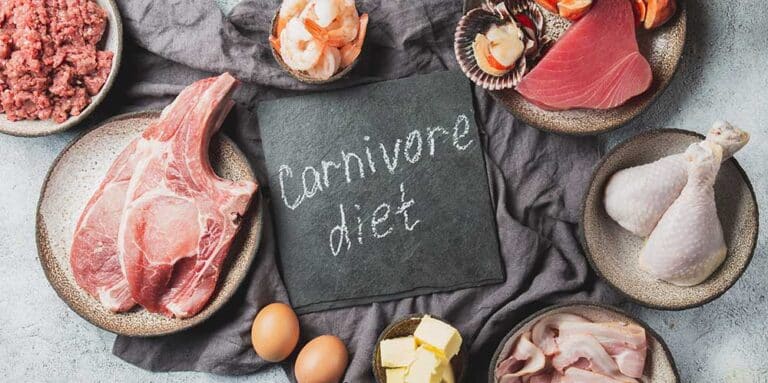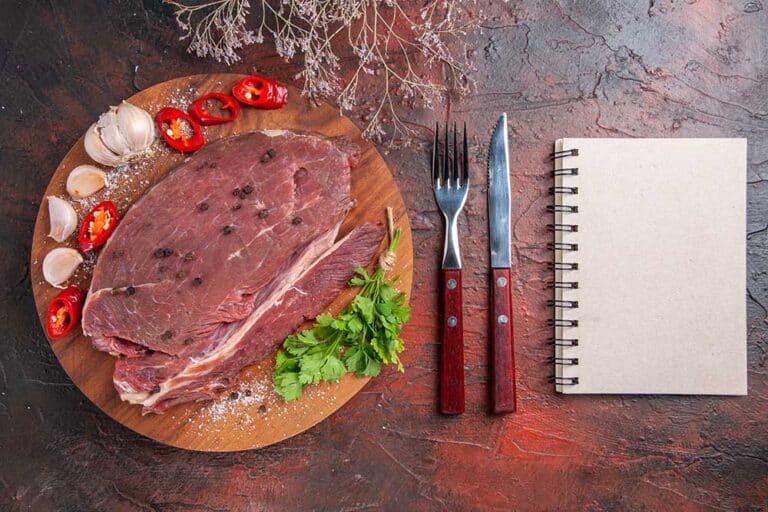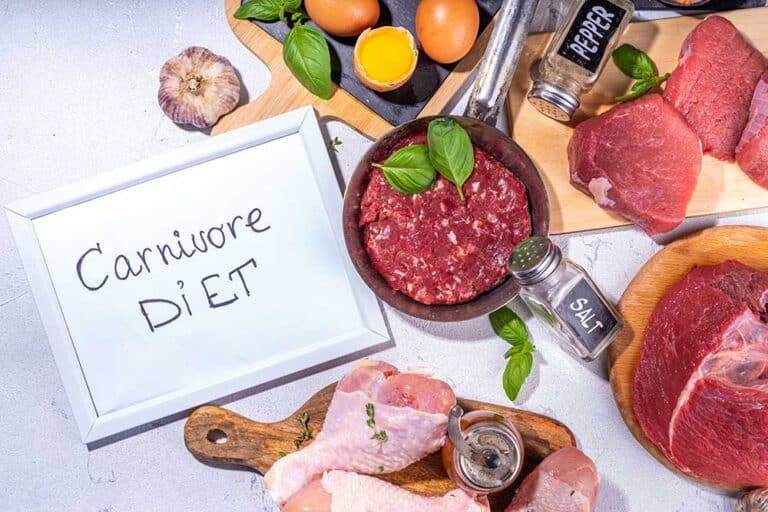Introduction to Carnivore Diet
Understanding the Carnivore Diet
The carnivore diet is a highly restrictive eating plan primarily consisting of animal-based foods. Followers of this diet consume various meats, including beef, chicken, pork, fish, and eggs. It may also include organ meats and less common parts of animals like fish eyes and bone marrow. Depending on personal preferences, some adherents might incorporate full-fat dairy, herbs, spices, condiments, and a few non-starchy vegetables (Primal Kitchen). For a detailed list of acceptable foods, visit carnivore diet foods list.
The main principle behind the carnivore diet is the elimination of all carbohydrates, leading the body to burn fat for energy. Unlike the keto diet that allows some plant-based fats and vegetables, the carnivore diet strictly limits food intake to animal products (Primal Kitchen).
Health Benefits of the Diet
There are several potential health benefits associated with the carnivore diet. These include:
- Weight Loss: By focusing on protein and fat, the diet may help in reducing calorie intake, thereby promoting weight loss (WebMD). For more about weight loss on this diet, visit carnivore diet weight loss.
- Reduced Inflammation: Some evidence suggests this eating plan can help fight inflammation, which may alleviate symptoms for individuals with chronic inflammatory conditions (WebMD).
- Blood Sugar Regulation: The diet’s elimination of carbohydrates may help in lowering blood sugar levels, which is particularly beneficial for people with diabetes (WebMD).
- Improved Mental Health: Some followers report better mental clarity and mood stability while on the carnivore diet (WebMD). Learn more at carnivore diet benefits.
| Potential Benefits | Description |
|---|---|
| Weight Loss | Promotes fat burning and reduces calorie intake |
| Reduced Inflammation | Helps alleviate symptoms of chronic inflammation |
| Blood Sugar Regulation | Lowers blood sugar in individuals with diabetes |
| Improved Mental Health | Better mental clarity and mood stability |
To maximize the benefits and mitigate potential risks, it’s crucial to adhere to the carnivore diet rules and consult with a healthcare provider before starting the diet. For a more comprehensive understanding of the impact this diet may have, check out carnivore diet before and after and carnivore diet results.
Next, dive into our exciting carnivore diet recipes to add variety to your meal plan.
Carnivore Diet Recipes
For individuals following the carnivore diet, finding versatile and delicious recipes is key to maintaining interest and satisfaction. Below, we dive into three mouth-watering carnivore diet recipes: PKD Adapted Shepherd’s Pie, Mozzarella-Stuffed Meatballs, and Ground Beef Stroganoff.
PKD Adapted Shepherd’s Pie
This PKD (Paleolithic Ketogenic Diet) adapted version of Shepherd’s Pie replaces traditional ingredients with those that fit within the carnivore diet framework. It is an excellent way to enjoy a comforting meal while staying true to your dietary goals.
Ingredients:
- Ground beef (2 lbs)
- Beef liver (0.5 lb)
- Bone marrow (0.5 lb)
- Beef broth (1 cup)
- Salt, to taste
Instructions:
- Preheat your oven to 350°F (175°C).
- Brown the ground beef in a skillet over medium heat.
- Add finely chopped beef liver and bone marrow, stirring until well mixed.
- Pour in the beef broth, season with salt, and let simmer for 15 minutes.
- Transfer the meat mixture to a baking dish and bake for 20 minutes.
- Serve hot and enjoy a nutrient-dense meal.
Mozzarella-Stuffed Meatballs
Mozzarella-stuffed meatballs are a delightful twist on a classic favorite. Perfect for lunch or dinner, these meatballs provide a rich taste combined with the creamy texture of mozzarella cheese.
Ingredients:
- Ground beef (1 lb)
- Mozzarella cheese balls (12 small)
- Egg (1)
- Parmesan cheese (0.5 cup, grated)
- Salt and pepper, to taste
Instructions:
- Preheat your oven to 375°F (190°C).
- In a large bowl, mix the ground beef, egg, Parmesan cheese, salt, and pepper.
- Divide the mixture into 12 equal parts and flatten each into a disk.
- Place a mozzarella cheese ball in the center of each disk, then shape the meat around it to form a ball.
- Place the meatballs on a baking sheet and bake for 25-30 minutes.
Ground Beef Stroganoff
Ground Beef Stroganoff is a creamy, satisfying dish that aligns perfectly with carnivore diet principles. This recipe swaps out traditional noodles for more meat to keep it within dietary guidelines.
Ingredients:
- Ground beef (1 lb)
- Butter (2 tbsp)
- Beef broth (1 cup)
- Sour cream (0.5 cup)
- Salt and pepper, to taste
Instructions:
- In a large skillet, melt the butter over medium heat.
- Add the ground beef and cook until browned.
- Pour in the beef broth and let it simmer for 10 minutes.
- Stir in the sour cream until well mixed, and season with salt and pepper.
- Cook for an additional 5 minutes, then serve.
These recipes are just a sample of the delicious options available for those following a carnivore diet. Be sure to explore our extensive list of carnivore diet meal plans for more inspiration. For more on what you can eat on the carnivore diet and other helpful tips, refer to our carnivore diet foods list, and what can you eat on the carnivore diet.
| Recipe | Preparation Time | Cooking Time | Servings |
|---|---|---|---|
| PKD Adapted Shepherd’s Pie | 20 mins | 35 mins | 6 |
| Mozzarella-Stuffed Meatballs | 15 mins | 30 mins | 4 |
| Ground Beef Stroganoff | 10 mins | 20 mins | 4 |
Breakfast and Brunch Options
Starting the day with a satisfying, nutrient-packed meal is essential, especially when following the carnivore diet. Here are two exciting breakfast and brunch recipes ideal for this diet.
Carnivore Casserole
The Carnivore Casserole is a hearty dish that combines various meats to create a flavorful and satisfying meal. This dish is perfect for anyone following the carnivore diet and looking for a robust start to the day.
Ingredients:
- 1 lb ground beef
- 4 oz bacon, chopped
- ¼ cup heavy cream
- 1 cup shredded cheese (optional)
- Salt and pepper to taste
Instructions:
- Preheat your oven to 375°F (190°C).
- Cook the bacon in a skillet over medium heat until crispy. Remove and set aside.
- In the same skillet, cook the ground beef until browned. Season with salt and pepper.
- Combine the bacon and ground beef in a baking dish.
- Pour the heavy cream over the meat mixture.
- Top with shredded cheese if desired.
- Bake for 20-25 minutes until the cheese is melted and bubbly.
| Nutrient | Amount per serving |
|---|---|
| Calories | 450 |
| Protein | 28g |
| Fat | 36g |
| Carbohydrates | 0g |
For more delicious recipes, visit our carnivore diet meal plan and explore what can you eat on the carnivore diet.
Meat Pie
The Carnivore Meat Pie is another great option for breakfast or brunch. This recipe utilizes a variety of meat cuts to provide a rich and satisfying dish that aligns with the carnivore diet principles.
Ingredients:
- 1 lb ground pork
- 1 lb ground beef
- 1 lb ground lamb
- 6 eggs, beaten
- ½ cup heavy cream
- Salt and pepper to taste
Instructions:
- Preheat your oven to 350°F (175°C).
- In a large skillet, cook the ground pork, beef, and lamb until browned and fully cooked. Season with salt and pepper.
- Drain excess fat and transfer the cooked meat into a mixing bowl.
- Add the beaten eggs and heavy cream, mixing well to combine.
- Pour the meat mixture into a pie dish.
- Bake for 30-35 minutes until the pie is set and golden brown on top.
| Nutrient | Amount per serving |
|---|---|
| Calories | 520 |
| Protein | 35g |
| Fat | 42g |
| Carbohydrates | 1g |
These breakfast and brunch options ensure you start your day with nutrient-dense, flavorful dishes that adhere to the carnivore diet. Discover more about the carnivore diet benefits and explore other carnivore diet recipes designed to keep you on track with your dietary goals.
Lunch and Dinner Selections
Lamb With Anchovy Aioli
Lamb with Anchovy Aioli is a delectable choice for those following a carnivore diet, providing a flavorful and nutrient-dense meal. Lamb, especially when sourced from grass-fed and pasture-raised animals, offers a rich supply of essential nutrients such as protein, vitamin B12, and iron. The anchovy aioli adds a delightful umami flavor that complements the lamb perfectly.
Ingredients:
- 1 rack of lamb, frenched
- Salt and pepper to taste
- 2 tablespoons olive oil
- 3 cloves garlic, minced
- 4 anchovy fillets, mashed
- 1 cup mayonnaise
- 1 tablespoon lemon juice
Instructions:
- Season the lamb rack with salt and pepper.
- Heat the olive oil in a skillet over medium-high heat.
- Sear the lamb rack on all sides until browned.
- Transfer to a preheated oven at 375°F (190°C) and roast until the internal temperature reaches 145°F (63°C).
- In a bowl, mix the minced garlic, mashed anchovies, mayonnaise, and lemon juice to make the aioli.
- Serve the roasted lamb with the anchovy aioli on the side.
For more lamb recipes suitable for the carnivore diet, check out our guide on what can you eat on the carnivore diet.
Lamb Ribs With Chermoula
Lamb Ribs with Chermoula offers a delightful and aromatic dish that is both satisfying and compliant with the carnivore diet. Chermoula is a marinade typically made with a mix of herbs, garlic, lemon, and spices, but for this carnivore version, it is modified to focus on animal-based ingredients while maintaining robust flavor.
Ingredients:
- 2 pounds lamb ribs
- Salt and pepper to taste
- 3 cloves garlic, minced
- 1 teaspoon ground cumin
- 1 teaspoon ground coriander
- 1/4 cup lemon juice
- 1/4 cup olive oil
Instructions:
- Season the lamb ribs with salt and pepper.
- In a blender, combine the minced garlic, ground cumin, ground coriander, lemon juice, and olive oil to make the chermoula marinade.
- Coat the lamb ribs with the chermoula marinade and let sit for at least 1 hour.
- Preheat the grill to medium-high heat or set the oven to 375°F (190°C).
- Grill or roast the lamb ribs until they reach an internal temperature of 145°F (63°C) and have a crispy exterior.
- Serve hot with an additional drizzle of chermoula.
For more diverse carnivore diet recipes for lunch and dinner, have a look at carnivore diet meal plan.
Nutritional Data
The table below provides a sample nutritional breakdown for the lamb dishes, showcasing the richness in protein and essential nutrients provided by these meals.
| Recipe | Calories | Protein (g) | Fat (g) | Carbohydrates (g) |
|---|---|---|---|---|
| Lamb With Anchovy Aioli | 470 | 30 | 35 | 1 |
| Lamb Ribs With Chermoula | 480 | 32 | 38 | 2 |
By incorporating these delicious lamb recipes into your carnivore diet, you can enjoy a variety of hearty and nutrient-packed meals while maintaining your dietary goals. For more information about potential risks and guidelines, consider reading our sections on diet restrictions and guidelines and nutritional deficiencies.
Carnivore Diet Considerations
When adopting the carnivore diet, there are several key considerations to keep in mind to ensure a safe and balanced approach to this unique nutritional plan.
Consulting Healthcare Provider
Before starting the carnivore diet, it is highly recommended to consult a healthcare provider. Given the diet’s elimination of most food groups except for meat, seafood, some dairy, and specific vegetables, medical advice is crucial for understanding potential health risks and benefits (Primal Kitchen).
The carnivore diet can stress the liver and kidneys due to the large amount of animal protein consumed. This stress has been linked to potential kidney issues and an increased risk of cancers, such as colon and rectal cancer (Baylor Scott & White Health). Hence, medical guidance is essential to mitigate these risks effectively.
Diet Restrictions and Guidelines
The carnivore diet consists mainly of grass-fed, pasture-raised meats, wild-caught seafood, organ meats, and other parts of the animal like fish eyes and bone marrow. To ensure a nutritious intake, it’s important to follow certain guidelines:
- Focus on Quality: Opt for grass-fed, pasture-raised meats and wild-caught seafood.
- Include Organ Meats: Incorporate organ meats to provide essential vitamins and minerals.
- Moderate Dairy Intake: Some variations of the diet include full-fat dairy. Use it in moderation.
- Limited Use of Non-Starchy Vegetables: Some followers may include limited amounts of non-starchy vegetables and herbs.
Despite these specific inclusions, the diet can be high in fat, cholesterol, and sodium, potentially lacking in certain micronutrients and fiber, essential for gut health (Healthline).
| Nutrient Concern | Potential Deficiency |
|---|---|
| Fiber | Gut health issues |
| Vitamins | Potential deficiencies in Vitamin C, K, and other plant-based nutrients |
| Minerals | Risk of missing out on minerals found in fruits, vegetables, and whole grains |
The carnivore diet may not be suitable for certain populations, such as individuals with chronic kidney disease, cholesterol hyper-responders, pregnant or lactating individuals, children, and those with a history of disordered eating (Healthline).
For those interested in a structured approach, see carnivore diet meal plan.
In following the carnivore diet, it’s crucial to adhere to these guidelines and maintain flexibility, consulting healthcare providers to adapt the nutritional intake as necessary. For further tips on making this transition, read about carnivore diet rules.
Potential Risks of the Carnivore Diet
Impact on Health Conditions
The carnivore diet, which focuses exclusively on animal products, presents significant risks to health. High consumption of fat, cholesterol, and sodium from animal sources can lead to cardiovascular diseases. Studies, including those from Baylor Scott & White Health, indicate that such dietary habits contribute to heart disease. The absence of dietary fiber, crucial for digestive health, may cause constipation and other gastrointestinal issues, impacting overall health.
Consuming large quantities of animal protein stresses the liver and kidneys. This stress can lead to kidney problems and is linked to an increased risk of certain cancers, including colon and rectal cancer (Baylor Scott & White Health).
Additionally, long-term adherence to the carnivore diet may elevate the risk for colorectal cancer and heart disease. Diets low in fruits and vegetables have been associated with higher mortality rates and an increased risk of various diseases.
| Health Condition | Potential Impact |
|---|---|
| Heart Disease | Increased risk due to high fat/cholesterol |
| Kidney Problems | Stress from high animal protein intake |
| Gastrointestinal Issues | Lack of fiber leading to constipation |
| Cancer | Higher risk of certain cancers due to high meat consumption |
Internal resources are available on carnivore diet side effects and the impact of the diet on specific health conditions.
Nutritional Deficiencies
The restrictive nature of the carnivore diet raises concerns about potential nutritional deficiencies. By excluding fruits, vegetables, grains, and legumes, individuals miss out on essential vitamins and minerals that are crucial for overall health.
Key nutrients typically lacking in the carnivore diet include:
- Vitamin C: Important for immune function and skin health.
- Vitamin K: Essential for blood clotting and bone health.
- Calcium: Crucial for bone health.
- Potassium: Important for heart and muscle function.
- Magnesium: Needed for muscle and nerve function.
These deficiencies can lead to a range of health issues, such as weakened immune function, poor bone health, and reduced muscle and nerve function.
| Nutrient | Importance |
|---|---|
| Vitamin C | Immune function, skin health |
| Vitamin K | Blood clotting, bone health |
| Calcium | Bone health |
| Potassium | Heart and muscle function |
| Magnesium | Muscle and nerve function |
While low-carb diets, including the carnivore variety, can improve health outcomes for individuals with diabetes (Health.com), the overall nutrient profile should not be overlooked. It’s essential to consult healthcare providers and follow diet restrictions and guidelines to mitigate these risks.
Explore more on our articles about what can you eat on the carnivore diet and understand carnivore diet benefits and considerations before adopting this dietary plan.
- About the Author
- Latest Posts
Johnnie D. Jackow Sr., the founder and CEO of Total Body Fitness, Worldwide, has a long-standing career in the fitness industry. He began as a certified personal trainer in the mid-90s and soon after authored his first weight loss book in 1998. This led to the launch of Total Body Fitness, Nationwide in the USA at the same time. Johnnie gained recognition as the fitness guru of his time, running infomercials on local TV late at night in Houston, Texas. Over the years, he has helped more than 40,000 individuals from all over the world achieve their health and fitness goals. With over 60,000 hours of documented training in integrative functional medicine, he completed his PhD in human physiology in 2010. His primary objective is to assist people in reaching their health and fitness goals through alternative approaches rather than relying solely on conventional medicine and pharmaceutical drugs. Today, with almost three decades of experience under his belt, Johnnie continues to be a leader in health and fitness.








